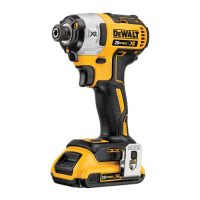18V product, it will operate
as an 18V battery. When the FLEXVOLT
TM
battery is
in a 54V or a 108V (two 54V batteries) product, it will
operate as a 54V battery.
Transport Mode: When the cap is attached to the
FLEXVOLT
TM
battery, the battery is in Transport
mode. Keep the cap for shipping.
When in Transport mode,
strings of cells are
electrically disconnected
within the pack resulting
in 3 batteries with a lower Watt hour (Wh) rating as
compared to 1 battery with a higher Watt hour
rating. This increased quantity of 3 batteries with the
lower Watt hour rating can exempt the pack from
certain shipping regulations that are imposed upon
the higher Watt hour batteries.
For example,
the Transport
Wh rating might
indicate 3x36
Wh, meaning 3 batteries of 36 Wh each. The Use
Wh rating might indicate 108Wh (1battery implied).
Battery Pack
BATTERY TYPE
The DCF887 operates on an 18 volt battery pack.
The DCB180, DCB181, DCB182, DCB183,
DCB183B, DCB184, DCB184B, DCB185, DCB186,
DCB546 or DCB547 battery packs may be used.
Refer to Technical Data for more information.
Storage Recommendations
1. The best storage place is one that is cool and
dry away from direct sunlight and excess heat
or cold. For optimum battery performance and
life, store battery packs at room temperature
when not in use.
2. For long storage, it is recommended to store a
fully charged battery pack in a cool, dry place
out of the charger for optimal results.
NOTE: Battery packs should not be stored
completely depleted of charge. The battery pack will
need to be recharged before use.
Example of Use and Transport Label Marking
Toxic fumes and materials are created when
lithium-ion battery packs are burned.
• If battery contents come into contact with
the skin, immediately wash area with mild
soap and water. If battery liquid gets into the
eye, rinse water over the open eye for
15 minutes or until irritation ceases. If medical
attention is needed, the battery electrolyte
is composed of a mixture of liquid organic
carbonates and lithium salts.
• Contents of opened battery cells may cause
respiratory irritation. Provide fresh air. If
symptoms persists, seek medical attention.
WARNING: Burn hazard. Battery liquid
may be flammable if exposed to spark or
flame.
Transportation
batteries comply with all applicable
shipping regulations as prescribed by industry
and legal standards which include UN
Recommendations on the Transport of Dangerous
Goods; International Air Transport Association
(IATA) Dangerous Goods Regulations, International
Maritime Dangerous Goods (IMDG) Regulations,
and the European Agreement Concerning The
International Carriage of Dangerous Goods by Road
(ADR). Lithium-ion cells and batteries have been
tested to section 38.3 of the UN Recommendations
on the Transport of Dangerous Goods Manual of
Tests and Criteria.
In most instances, shipping a
lithium-ion
battery packs when the package contains only
battery packs (no tools), and
2. Any shipment containing a lithium-ion battery
with an energy rating greater than 100 watt
hours (Wh). All lithium-ion batteries have the
watt hour rating marked on the pack.
Regardless of whether a shipment is considered
excepted or fully regulated, it is the shipper's
responsibility to consult the latest regulations for
packaging, labeling/marking and documentation
requirements.
Transporting batteries can possibly cause fire if the
battery terminals inadvertently come in contact with
conductive materials. When transporting batteries,
make sure that the battery terminals are protected
and well insulated from materials that could contact
them and cause a short circuit.

